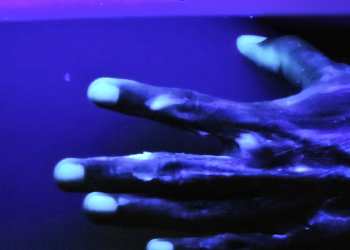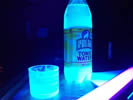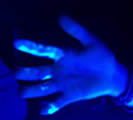A page from the "Causes of Color" exhibit...
Experiment with making glowing hands


Find out what happens when you take common petroleum jelly and a black light to create a ghoulish special effect!
Glowing Hands
What makes certain things glow under a black light?
Petroleum jelly contains chemicals called phosphors that absorb UV light, later emitting it as a light that we can actually see as part of the visible spectrum. This effect is mimicked here in this cool, but easy demonstration.
Ingredients
- A black light (or a lamp with a black light bulb)
- Petroleum Jelly
- Latex Gloves (or latex free if you are allergic!)
How to Do It
- Place the latex gloves on your hands
- Apply a generous amount of petroleum jelly to both hands and slather it on to cover.
- Once your hands are covered in petroleum jelly, ask a friend to turn off the lights in the room (the darker the room, the better the effect!)
- Once the lights are off, have the friend turn on the black light. Hold out your hands… what do you see? Why, your hands are glowing!
How it Works
To understand the reason this experiment works, we first need to discuss black lights. Black lights earn their name because they give off very little light that can be seen by us. Light in the visible spectrum ranges from red, orange, and yellow, to violet. Our eyes cannot detect light that exists beyond violet light in the visible spectrum. This light is called – you guessed it – ultraviolet light!
So if black light is light we cannot see… why does this work? Well, petroleum jelly contains substances called phosphors. Phosphors absorb radiation from the black light and then emit the radiation absorbed as visible light.
Tonic water is another household item that glows under UV-A rays of a blacklight.
The fluorescent dyes in laundry detergent will also glow.
Variations
- Try writing a message with petroleum jelly on a surface such as a slip of paper. Or draw a pattern on your hands rather than covering them completely. What kinds of applications can you think of for this neat trick?
- Want to see other examples of phosphors? White shirts usually glow fairly brightly when exposed to black lighting. Laundry detergents contain additives called bluing agents. Bluing agents are thought to make whites whiter. The truth is, bluing agents contain phosphors. Their presence is even more obvious during exposure to black lights.
- Another example of phosphors can be found in your wallet. Newer $20, $50, and $100 bills contain a security thread that glows when exposed the ultraviolet black light. This makes the bill harder to counterfeit. Got a bill? Try it out!
- There are two types of ultraviolet light emitted from the sun. Ultraviolet B light is higher in energy than the light that is emitted from black lights – Ultraviolet A. Sunburn is caused by UV-B light. A black light cannot give you a burn. What happens if you use a mixture of sun block and petroleum jelly? Since sun block absorbs UV-A light rays, the phosphorescence effect should be cancelled. Try smearing a thin layer of petroleum jelly on a small piece of poster paper. Then using sun block, squirt or paint on a message. Turn on a black light and see what happens. What happens to the areas with the sun block?
- Want to try out some other household items that glow? Try using any of these as an invisible ink solution: tonic water with quinine, vinegar, a diluted solution of laundry detergent and water.
Something to Think About
The inside of a fluorescent bulb is ultraviolet light, and the outside has phosphors. Fluorescent black lights are created this way as well, except that only one phosphor is used and the normally clear glass envelope of the bulb may be replaced by a deep-bluish-purple glass called Wood’s glass, a nickel oxide treated glass, which blocks almost all visible light above 400 nanometers.





